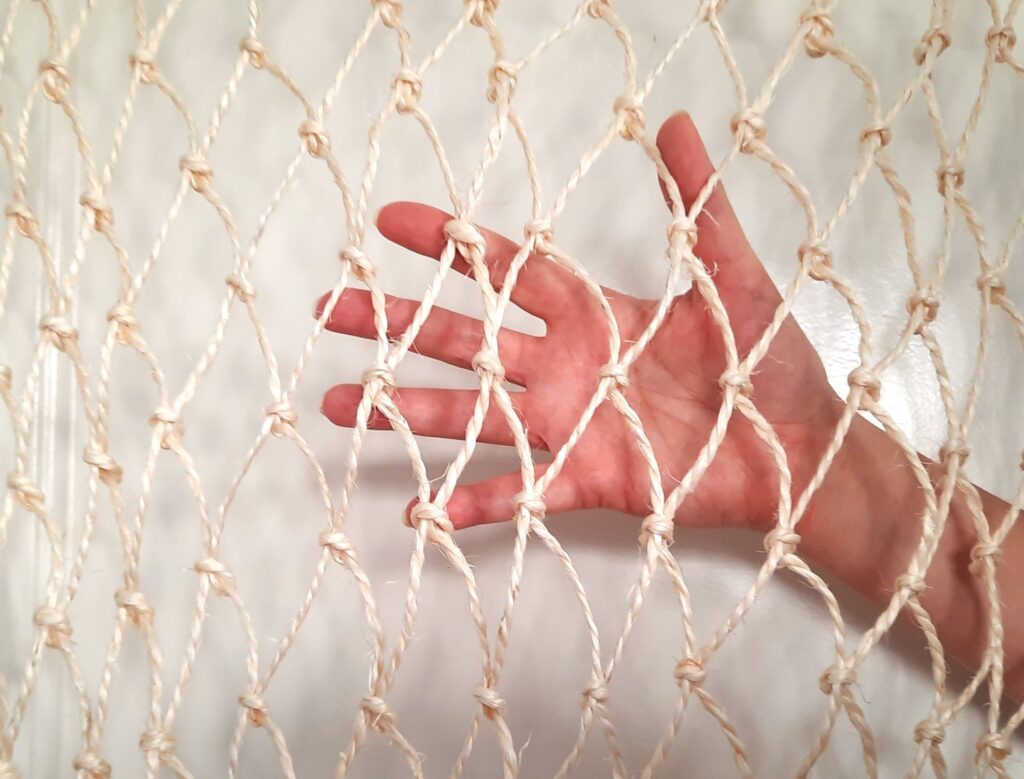/ cero uno

Homepage: www.lucia-madriz.com , @luciamadriz_artist, @_cero_uno_
OBRA- Español.
Lo que nos une,
lo que nos separa (2024)
Sisal y algodón
120 x 250 cm
La obra de Lucía es una instalación que consiste en una red hecha de la fibra natural llamada Pita o Ixtlle, como se le llama en México. Esta fibra natural viene de la planta de origen mesoamericano Magüey, que fue introducida a España por los colonizadores españoles. Esta planta se ha utilizado en toda la región mesoamericana desde la época precolombina y es un material que ha sido incorporado a la identidad ibicenca y se utiliza para hacer artesanías tradicionales como las famosas espardenyas.
La artista utiliza también el algodón. Existen dos variedades de esta planta que son de origen Americano gossypium hirsutum y gossypium barbadense, actualmente los tipos de algodones más consumidos en el mundo, y cuyo cultivo está ligado a una historia de explotación y violencia.
ARTWORK- English
What bringt us together
What bringt us apart (2024)
Sisal and cotton fibers
120 x 250 cm
Lucía’s work is an installation that consists of a network made of the natural fiber called Pita or Ixtlle, as it is called in Mexico. This natural fiber comes from the Mesoamerican plant Magüey, which was introduced to Spain by the Spanish colonizers. This plant has been used throughout the Mesoamerican region since pre-Columbian times and is a material that has been incorporated into the Ibizan identity and is used to make traditional crafts such as the famous espardenyas.
The artist also uses cotton. There are two varieties of this plant that are of American origin, gossypium hirsutum and gossypium barbadense, currently the most consumed types of cotton in the world, and whose cultivation is linked to a history of exploitation and violence.

BIO – Español.
Lucía Madriz (San José, 1973)
Estudió Bellas Artes en la Universidad de Costa Rica (2000) y fue galardonada con la Beca para artistas extranjeros del DAAD -Servicio Alemán de Intercambio Académico- para estudiar en la Hochschule für Gestaltung- Karlsruhe (2003-4).
Su obra ha sido exhibida en Casa América, Madrid (2021); Palais de Tokyo, París (2018); SESC Belezinho, Sao Paulo (2018), Pratt Manhattan Gallery, Nueva York (2016), Museum of Arts and Design MAD, Nueva York (2010). Ha participado en diversas bienales como la 55ª Bienal de Venecia (2013), la 8ª Bienal del Mercosur (2011), la Bienal del Fin del Mundo, Ushuaia (2011), la I Bienal de Cartagena (2014), la X Bienal Centroamericana (2016), entre otras. Algunas exposiciones que vale la pena mencionar son „After Eden“, Centro Humboldt para la Gestión Ambiental, Managua (2021); „Killing Fields“ curada por Berta Sichel, Galería Freijo, Madrid (2018), „Utopia-MINGA Arts Collaboratory + Fundación TEOR/éTica“ (2015-6), „El Tesoro de Lima“ de Thyssen Bornemisza Art Contemporary Academy en la Isla del Coco (2014), „Cool Stories for when the Planet gets hot IV“ de Artport e Inteligencia Natural con la Unión Internacional para la Conservación de la Naturaleza -UICN en San José (2013).
Su obra aparece en el libro „Latin American Artists from 1785 to Now“, publicado por Editorial PHAIDON en Londres, en octubre de 2023 y este año recibió el Premio Nacional en Artes Visuales Francisco Amighetti del Museo de Arte Costarricense. Actualmente es parte del equipo de cero uno, un espacio independiente de artistas para artistas de San José, Costa Rica.
BIO – English
Lucía Madriz (San José, 1973)
She studied Fine Arts at the University of Costa Rica (2000) and was awarded the DAAD -German Academic Exchange Service- Scholarship for foreign artists to study at the Hochschule für Gestaltung- Karlsruhe (2003-4).
Her work has been exhibited at Casa América, Madrid (2021); Palais de Tokyo, Paris (2018); SESC Belezinho, Sao Paulo (2018), Pratt Manhattan Gallery, New York (2016), Museum of Arts and Design MAD, New York (2010). Lucía has participated in several biennials such as the 55th Venice Biennial (2013), the 8th Mercosur Biennial (2011), the Biennial of the End of the World, Ushuaia (2011), the I Biennial of Cartagena (2014), the X Central American Biennial (2016), among others. Some exhibitions worth mentioning are „After Eden“, Humboldt Center for Environmental Management, Managua (2021); „Killing Fields“ curated by Berta Sichel, Freijo Gallery, Madrid (2018), „Utopia-MINGA Arts Collaboratory + TEOR/éTica Foundation“ (2015-6), „El Tesoro de Lima“ by Thyssen Bornemisza Art Contemporary Academy in Cocos Island (2014), „Cool Stories for when the Planet gets hot IV“ by Artport and Inteligencia Natural with the International Union for Conservation of Nature -IUCN in San José (2013).
Her work appears in the book „Latin American Artists from 1785 to Now“, published by Editorial PHAIDON in London, in October 2023 and this year she received the Francisco Amighetti National Award in Visual Arts from the Museo de Arte Costarricense. She is currently part of the team of cero uno, an artists run space in San José, Costa Rica.
